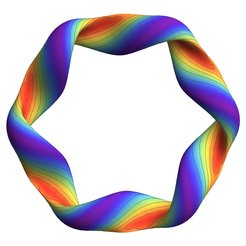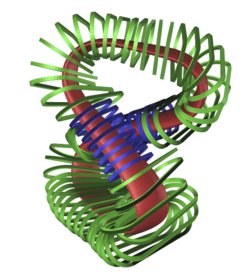Stellarator Concepts Group (SCG)
- The Stellarator Concepts Group (SCG) develops novel stellarator designs to push the limits of what can be achieved in future devices, from laboratory experiments to reactors and fusion power plants.
- We tackle critical problems like turbulence reduction, plasma confinement and coil complexity, but also study underlying questions that define optimized stellarators, leading to alternative topologies and symmetries.
- Guided by plasma physics, we develop our own theoretical and computational tools and methods to accelerate the search for new stellarator designs.
Our interests are fundamental, and serve a strategic need for the development of viable and economical solutions for fusion energy.
Role
Scientists working in stellarator optimization play the role of architects, applying theoretical plasma physics, continually informed by experimental progress, to draft concepts for future experiments and devices. The end result is a “magnetic configuration”, essentially the shape of a magnetic field and its electromagnetic coils, which sets the physics properties of the plasma confined within it. Such configurations serves as the basis for all further work toward a device design.
Here our collaborators come in, including engineers and other experts in fusion science and technology, like those in IPP’s own reactor studies group, and a number of private companies aiming to commercialize and accelerate the development of fusion energy, e.g. Proxima Fusion, Gauss Fusion, and Thea Energy. Each group has its own vision and needs for future devices.
Research Highlights
Stable Quasi-Isodynamic Designs (SQuIDs)
SQuIDs are stellarator designs first discovered in the Stellarator Concepts Group. They were found using a breakthrough methodology that realizes the promise of quasi-isodynamic (QI) stellarators, balancing fast particle confinement with unmatched plasma stability [1]. Beyond this, they are further optimized for enhanced plasma confinement via reduced turbulence. They follow proudly in the tradition of Wendelstein 7-X, but overcome its limitations, making them uniquely promising as a basis for a reactor.

Critical Gradient (CG) Optimization

Turbulence, the main mechanism of heat loss in magnetic fusion plasmas, has — from the perspective of stellarator optimization — been viewed as something to minimize. The idea of critical-gradient optimization, is to instead focus on modeling the plasma conditions at which the onset of turbulence occurs, e.g. the so-called critical ion temperature gradient [2].
The Quasi-Symmetric Turbulence Konzept (QSTK) is a quasi-hellically symmetric stellarator designed using CG optimization to achieve enhanced confinement, as extensively demonstrated by numerical simulations, in conjunction with other key properties desired in a fusion device [3].
The CG optimization method is currently being extended to QI stellarators.
Theoretical Foundations
Fundamental theory, like the asymptotic solutions of magnetic equilibria, guides the stellarator design process.

- Breaking axisymmetry while preserving quasi-axixymmetry defines a class of distinctive solutions [4], which have inspired the compact Stellarator-Tokamak Hybrid, a line of devices being pioneered by SCG collaborator Sophia Henneberg [5].
- Near axis theory has revealed a space of QI stellarators shapes larger than once imagined, with distinct topological properties and symmetries. The systematic exploration of this space is underway, in collaboration with E. Rodriguez, enabled by advances in near-axis theory [6, 7].
- Historically, the first stellarator design was Lyman Spitzer’s figure-8. This elegant form bears little resemblance to the sculpted shapes that typically result from numerical optimization, but still has lessons left to teach: By re-imagining Spitzer’s device as a modern quasi-isodynamic stellarator, we find a device with a radically simple planar-coil design [8]. This work continues in collaboration with the MHD group lead by F. Hindenlang [9].
References


